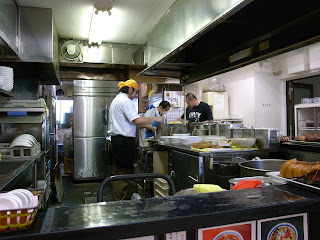If you have no interest in walking or photography, that's still OK, as the bowl of Ramen is interesting and good enough to go all the way there. It is also a big favorite among the college's students and you will see many of them in there.
What's so special about this place is the noodles, and most of the people will agree with me in saying that they are pasta-like: they have the egg-yellow color, more or less the taste and definitely the firmness of slightly al dente Italian pasti. I think that's quite original but I know for a fact that some hardcore Ramen-eaters find that a blasphemy. Well, that's too bad for them, as the "Togarashi Ramen" (chili ramen) I had yesterday was excellent.
The broth in Ramen Yamate is Tonkotsu-based (pork bone), to which they add some Tori-Gara (chicken carcass), Konbu (tangle), garlic, ginger and Shiitake mushroom, all of which they simmer for 24 hours. This makes a light-flavored Tonkotsu soup that I find very appetizing.
Friends from college who are readins this blog (thank you) might remember our favorite "Akashiroya" in Yoyogi-Uehara (the place is gone now). Well, "Ramen Yamate" is the mother shop and tastes quite the same.
Yamate's most popular dish is the "Yuki (snow) Ramen" which consists of that basic broth with toppings of roasted garlic and onion, and a final thin layer of lard on top of the soup. That light blanket of fat, which supposedly adds smoothness to the broth, looks like snow, hence the name of the dish.
As mouth-watering as that sounds, as I said earlier, I went for the "Togarashi Ramen" which is a hot version of the basic broth, with added chili in it. The soup looks hellishly red and spicy, but that's really on the surface, and they manage to keep it very eatable. The soup actually tasted so good that I even thought for a while of downing it, but fought such calorie mega-intake with courage.
The ramen comes with Menma (Japanese style Sungan) and a slice of Chashu (Chinese-style bbq pork) that somehow tastes a little bit and has the fibrous texture of canned tuna. Both toppings are a little too low on salt for my liking, which is a shame as they definitely need more flavor to compete with the rich spicy soup
The pasta-like noodles are freshly made on site (the "noodle factory" is next door) by the manager and were originally studied and designed as to give the best Nogo-Doshi possible (literally Passing the Throat), an important notion in Japan where firmness of food can be a matter of lengthy heated discussion. Nodo-Goshi can designate anything from firmness, smoothness or fluidity, but is really basically about how easily and enjoyably you'll down the stuff.
Even after more than 30 years in Japan, Nodo-Goshi is still a slightly difficult notion to grasp for me, so let me just say that their noodles provide a nice resistance, are tasty and are a pleasure to swallow with a little bit of soup. Once again, Ramen purist might tell you that they do not mingle well with the broth, but that's the least of my concerns.
 Whether it has something to do with the fact that the noodles do seem a little "Italian", I don't know, but Yamate also offers a "Tomato Ramen" (left on the picture above), with Italian tomatoes, wine, aromatic herbs and chili-infused Olive oil, which might be a wonderful match for the "pasta". If you're in a challenging mode, go crazy...
Whether it has something to do with the fact that the noodles do seem a little "Italian", I don't know, but Yamate also offers a "Tomato Ramen" (left on the picture above), with Italian tomatoes, wine, aromatic herbs and chili-infused Olive oil, which might be a wonderful match for the "pasta". If you're in a challenging mode, go crazy... "Ramen Yamate" (mid to far right) and the "Noodle Factory" (left)
"Ramen Yamate" (mid to far right) and the "Noodle Factory" (left)Ramen Yamate is open everyday from 11:30am to 02:45am
You can walk there from Shimokitazawa (30mn), Higashi-Kitazawa (20mn) on the Odakyu Line or 10mn from Komaba-Todaimae (2 stations from Shimokitazawa on the Inokashira Line)
Shibuya-ku, Tomigaya 2-21-7
You can walk there from Shimokitazawa (30mn), Higashi-Kitazawa (20mn) on the Odakyu Line or 10mn from Komaba-Todaimae (2 stations from Shimokitazawa on the Inokashira Line)
Shibuya-ku, Tomigaya 2-21-7























